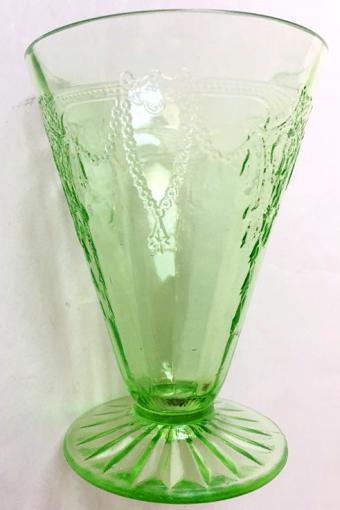
Depression glass patterns range from simple to ornate, and their beauty sparkles just as brightly decades after they were produced. Whether you collect Depression glass or simply love the style and history of these antiques, you'll enjoy these beautiful designs.
Eight Depression Glass Patterns to Collect
If you're considering starting a collection of Depression glass, it's fun to look at patterns to see the variety. You'll see everything from Depression glass stemware to serving pieces, and there are dozens to choose from. These are a few pictures of Depression glass patterns you're sure to love.

Cherry Blossom by Jeanette Glass
The Cherry Blossom pattern is one of the most popular and beautiful Depression glass patterns out there. The delicate design features cherries, leaves, and flowers. The pattern came in pink, blue, green, clear, and other shades. According to Replacements.com, it was made between 1930 and 1939.

Anchor Hocking Moonstone
The Moonstone pattern is another beautiful design. This Depression glass pattern was put out by Anchor Hocking. It has clear hobnails with milky white edges. It was manufactured from 1942 through 1946, placing it just after the Great Depression.

Patrician Pattern by Federal
Sometimes called the "spoke pattern," this Depression glass pattern was manufactured by Federal from 1933 to 1937. It came in clear, green, pink, and amber as shown here. Green or pink depression glass has more value than other colors, albeit slightly more.

Anchor Hocking Waterford
Although it doesn't have the high-end glitter of Waterford crystal, this faceted pattern from Anchor Hocking is almost as elegant. Manufactured from 1938 to 1944, it comes in clear. You'll find everything from salt and pepper shakers to cereal bowls in this geometric design.

Sunflower by Jeanette Glass
Another lovely floral design from Jeanette Glass, this Depression glass pattern features all over sunflowers with a large center medallion. It came in pink, green, blue, and several other rare and experimental colors. It was produced between 1930 and 1935.
Royal Lace by Hazel Atlas
This stunning Depression glass pattern by Hazel Atlas offers a refined touch on simple glassware shapes. Made between 1934 and 1941, it came in royal blue, pink, clear, green, and other shades.

American Sweetheart by Macbeth-Evans
Made between 1930 and 1936, American Sweetheart is a classic Depression glass pattern by Macbeth-Evans. It features a simple floral design and delicate scrolls and came in a variety of colors including pink and white.
Anchor Hocking Cameo
Cameo by Anchor Hocking is an early pattern, made at the start of the Great Depression between 1930 and 1934. This pattern features swags and florals and is a classic choice. The most popular color it came in was green.

More Pink Depression Glass Patterns
If you love collecting pink Depression glass, it's a good idea to familiarize yourself with more patterns in this beautiful color. Peruse pictures of pink Depression glass patterns to see what you should look for in antique shops and online.

More Green Depression Glass Patterns
Green Depression glass also came in some gorgeous patterns and styles. Take some time to look at photos of green Depression glass to find the perfect pattern or shade for you.

Identifying Fake Patterns
If you have a piece of Depression glass and need to know if the pattern is fake, the first step is identifying glass markings on the piece. Turn it over and check for any identifying marks. The glass piece itself should be fairly thin. Examine the quality of the pattern. It should be smooth and delicate looking - not chunky. Also look for spots where the pattern is briefly interrupted with mold lines or seams. Being familiar with Depression glass patterns will help you learn to identify fakes as well.







